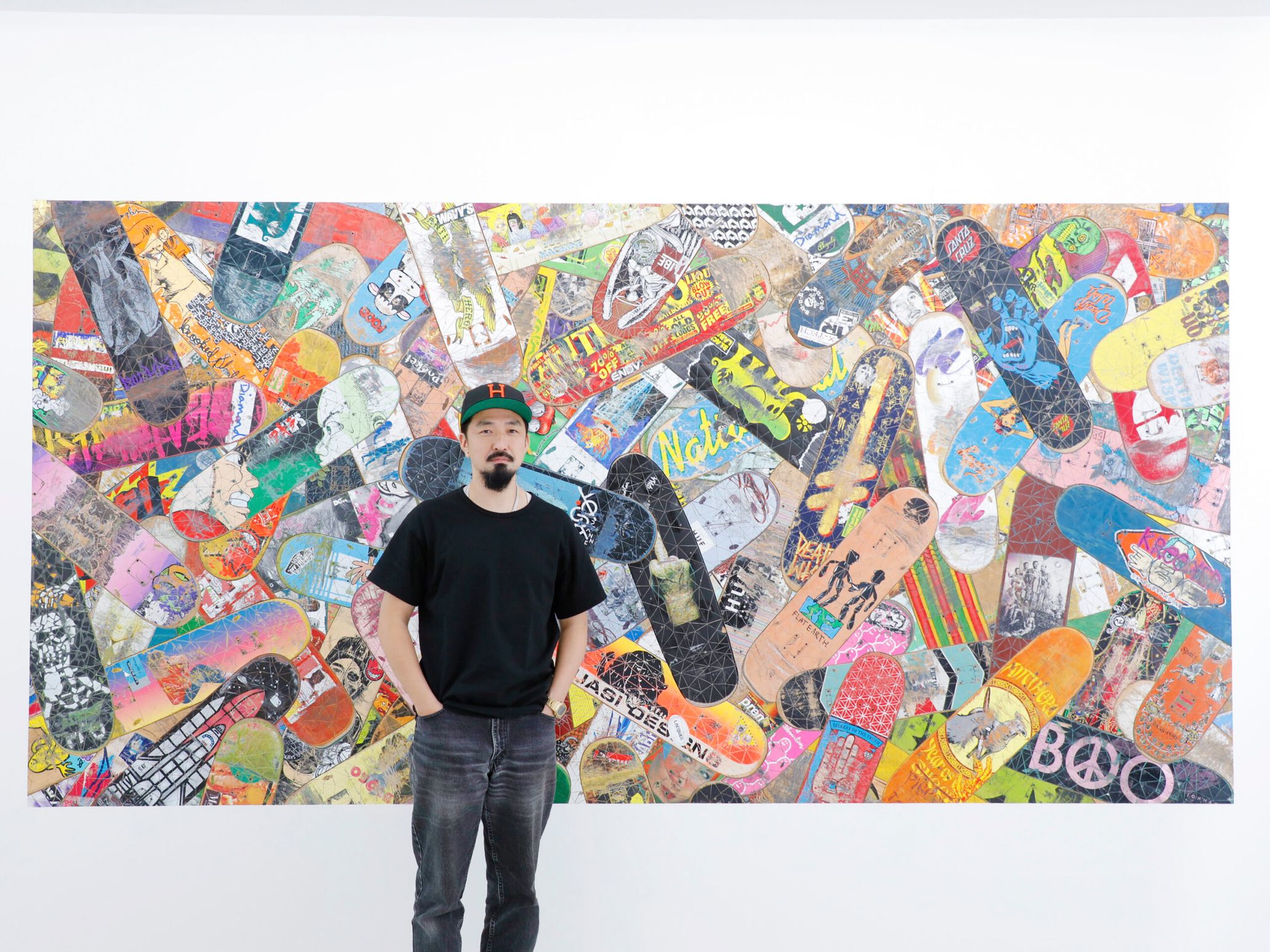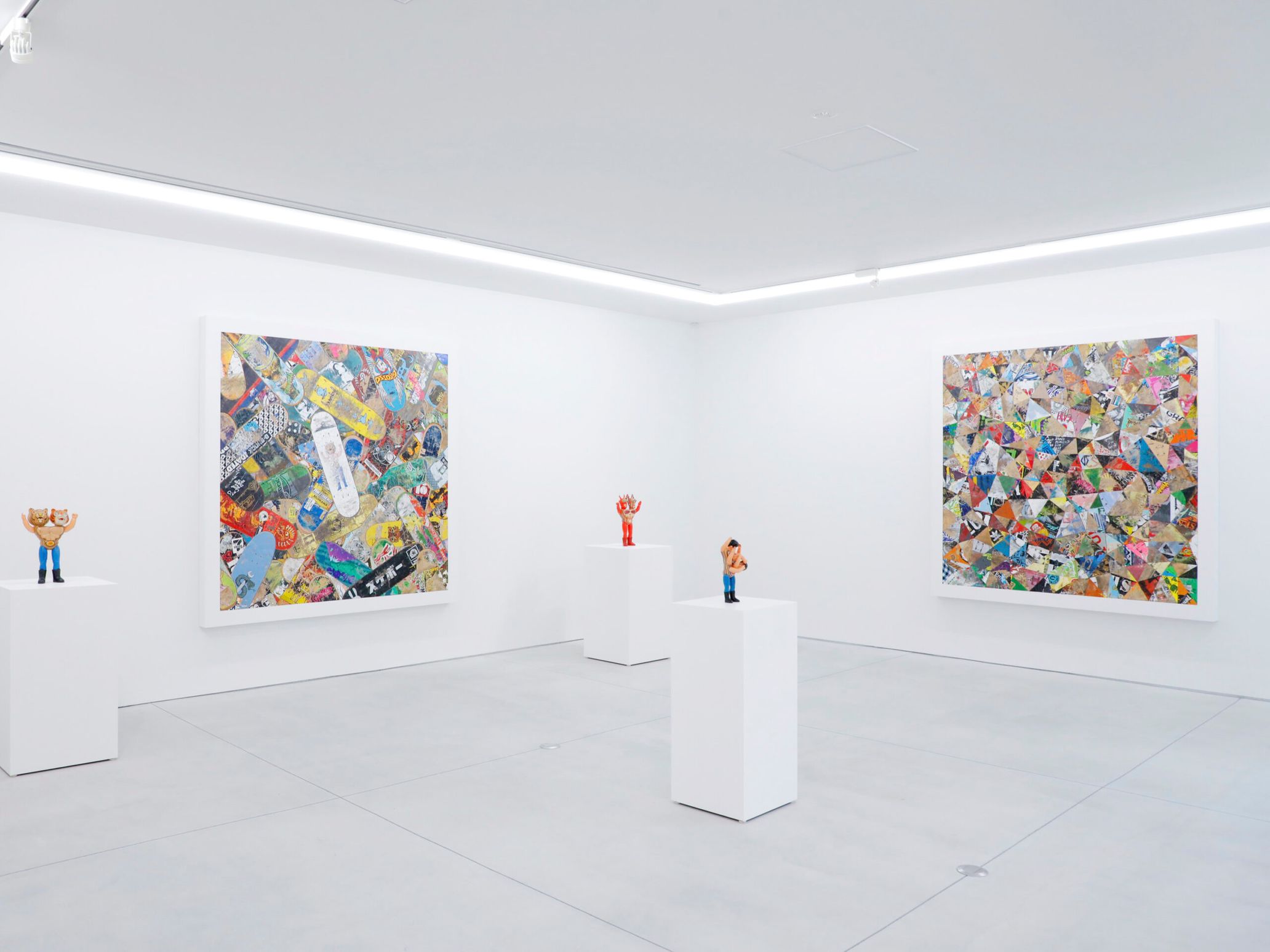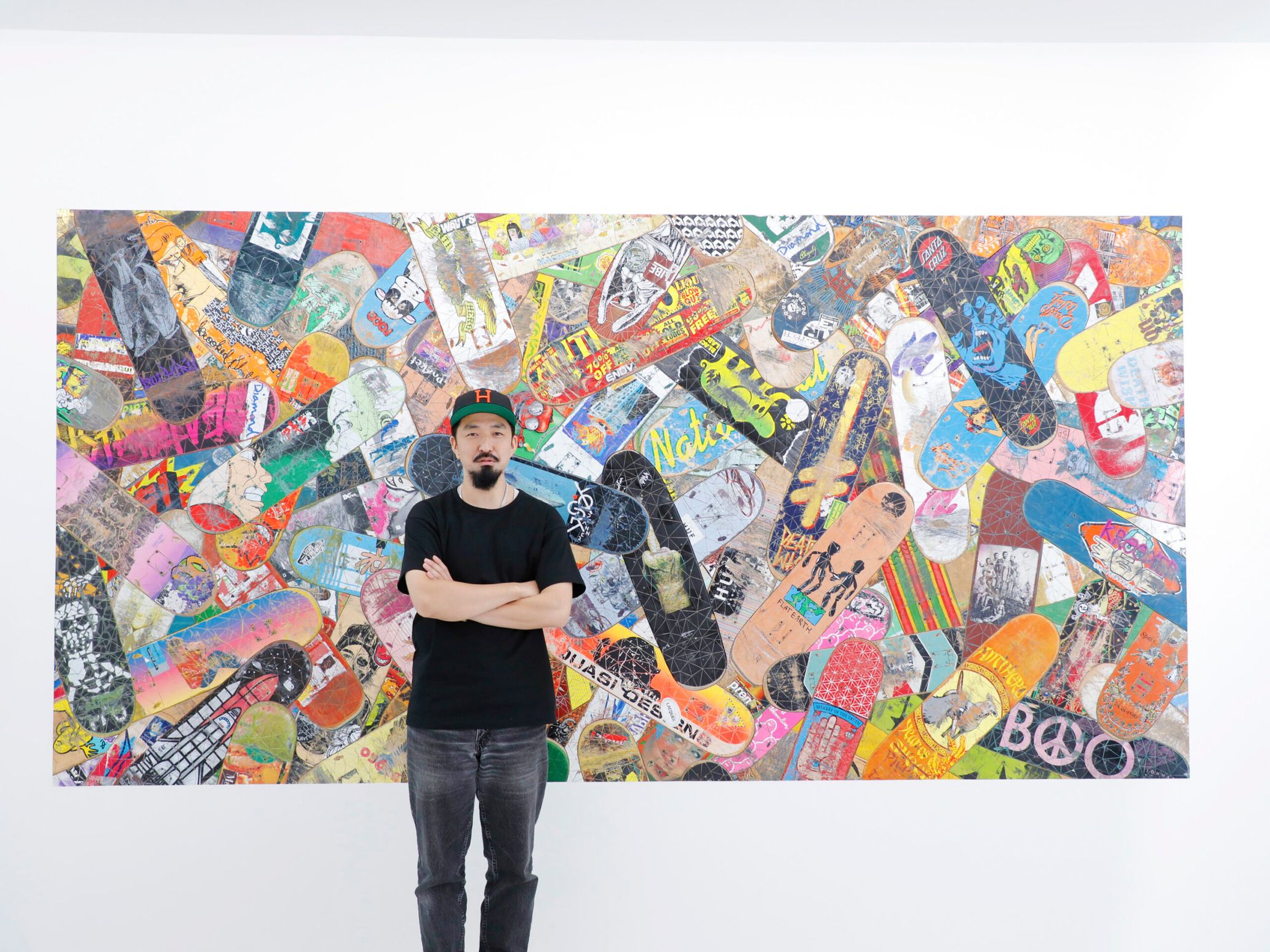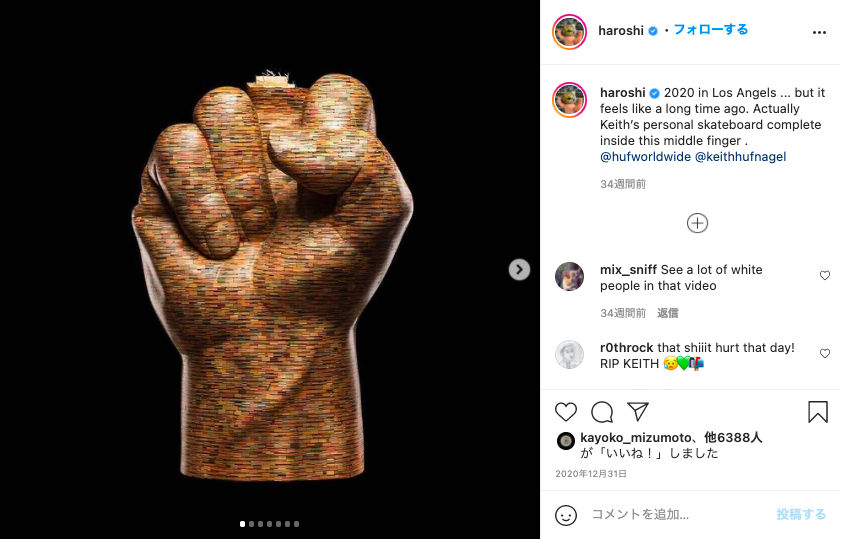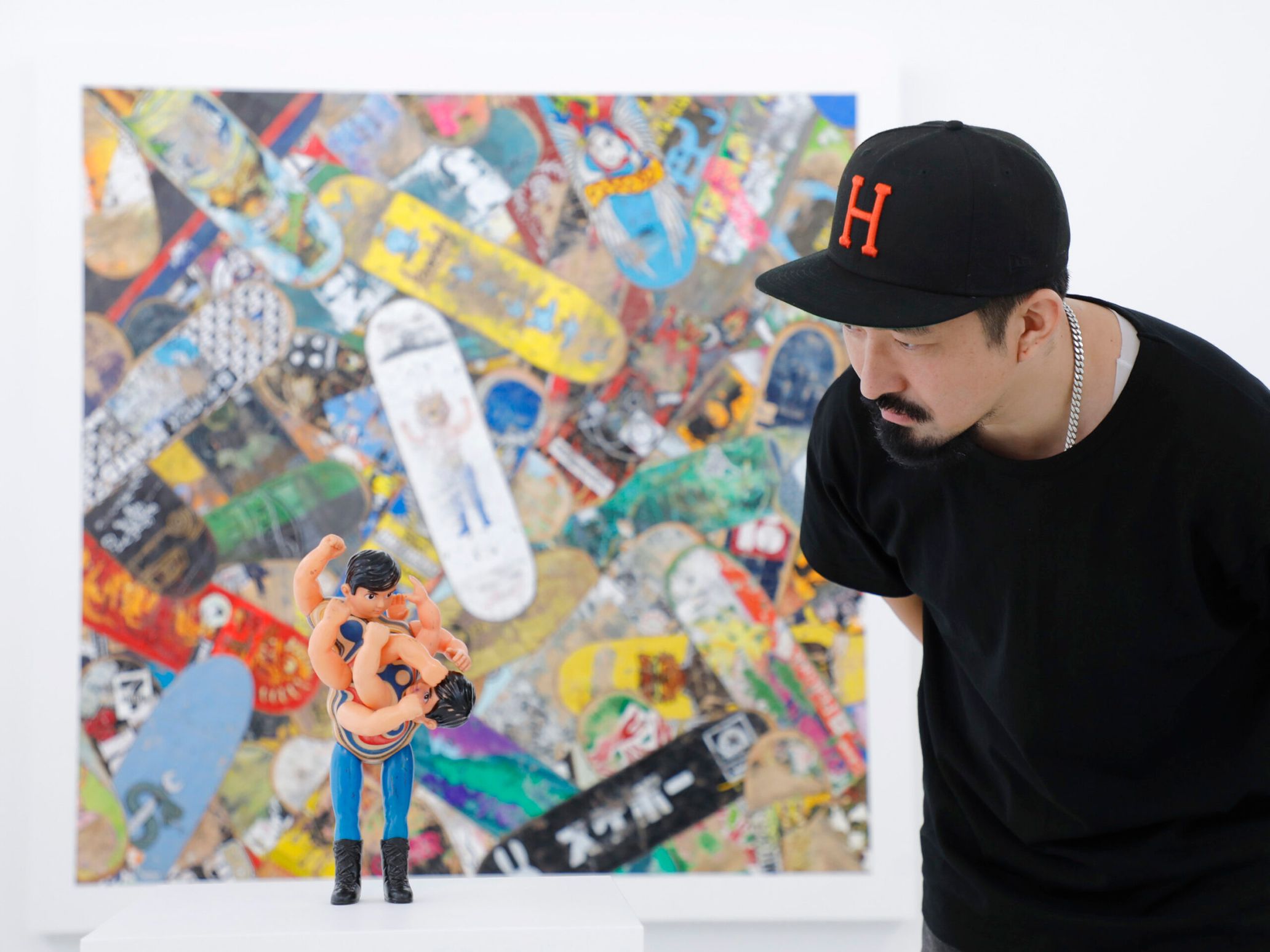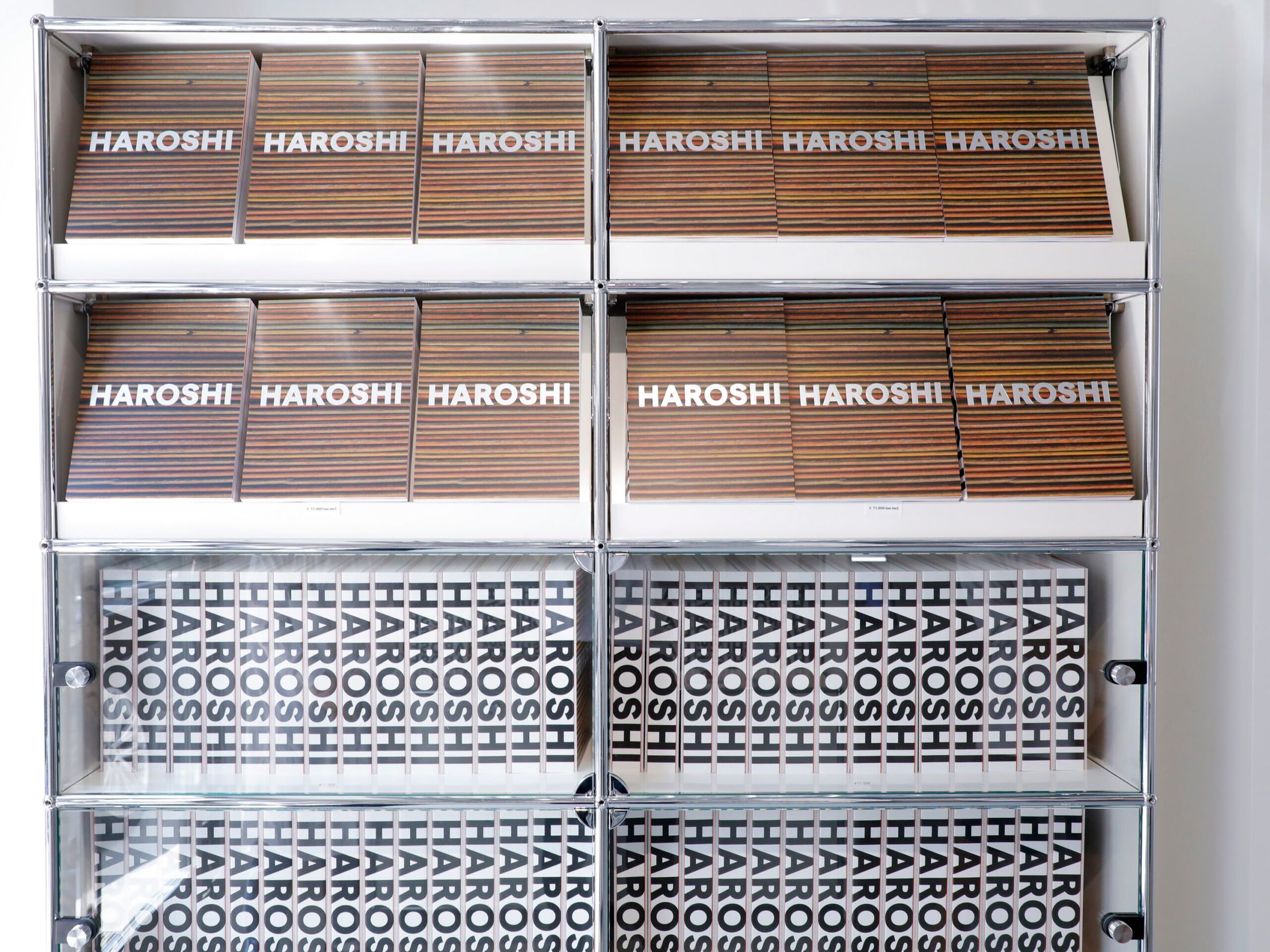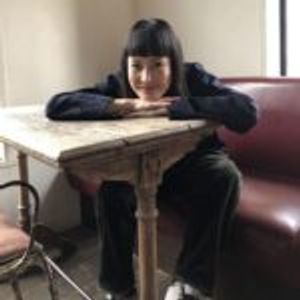Haroshi is an artist, who creates art from used skateboard decks. The modern artist who is not only celebrated in the world of skateboarding, but well sought-after all around the world, had held his solo-exhibition, I versus I, at the gallery that newly opened this year, NANZUKA UNDERGROUND. The exhibition exuded his passion towards the cultures of custom-made, street, and skateboarding.
Following the first part of the interview, where we were able to learn about his sentiments toward custom-made culture, how he started using sofubi for his works, and “GUZO” carved out of skateboards, in part two, we take a look into Haroshi’s thoughts toward street culture, his stories with his irreplaceable friend—the founder of Huf—Keith Hufnagel, and about the titles in the collection.
Placing everything with my own hands
ーーHow do you collect these skateboard decks?
Haroshi: There’s a shop that’s been sending me used skate decks since the beginning of my career, and they send me a lot on a reg. I think I have over 1,000 decks at home [laughs].
ーーHow do you sort them out?
Haroshi: First, I tear off all the deck tapes and decide whether I want to make a sculpture or a 2D art. Beat-up skateboard decks can’t be used for 2D art like “Mosh Pit.” Basically, they don’t look good as the graphics are completely faded and gone. So, I put the worn-out decks in a pile and use them to create “GUZO.” I put the ones that seem to be in a good shape to the side. I check and decide like, this should be for 2D art, this should be for sculpture—and sometimes, there are ones with florescent colors that can be used as accent, or ones with gold foil that can be used for something special. I decide carefully on how to use the ones with nice graphics or nice colors on the sides.
ーーI saw the process of making the 2D art on your Instagram, and you were spreading out all the decks on the floor.
Haroshi: It’s always like that—I place the decks randomly on the floor and once it looks good, I get on a ladder and take pictures from above; then it’s a constant task of printing out the pictures, cutting and putting them together.
ーーSo, you don’t use a computer to do all that?
Haroshi: No, because I don’t know how to use photoshop. I know it would be way better to do it digitally. I did an exhibition before this in New York at a gallery called Jeffrey Deitch and made about a 5m x 5m sized “Mosh Pit.” It was too big and difficult to work on it in Japan as I didn’t have enough space for it, so I printed out pictures of the skateboards in a smaller size to figure out the layout. However, it didn’t work out. It was just hard to decide on a sheet of paper.
ーー5m is tall as a 2 story building….
Haroshi: That’s right. It’s enormous. Since then, I realized that I need to figure out the layout using real decks and place them with my own hands; I do it manually to this day.
ーーCan you tell us about your love towards street culture? Or in other words, what do you like about street and skateboarding culture?
Haroshi: My love towards street culture….
ーーAs you produce art using skateboards, I thought you might be infusing identities born from skate culture into your artworks.
Haroshi: It’s hard to explain. Well, in the beginning, I used to always say that skateboard is all I have. There’s a man in Brazil making sandals out of tires. He probably started off casually just by picking up the tires that he sees everywhere around him, and for me, it’s the same but they weren’t tires and they were skateboards instead. It’s simple as that. I wasn’t looking for a specific material that I can make a career out of and be like “this is the one!” I just happen to be doing what I’m doing. It’s always better to go with things that come about naturally to you.
The crux of BLM I learned from Keith Hufnagel
ーーI’ve noticed that there’s a Huf deck in the center of “Mosh Pit.” Is this a tribute to Keith Hufnagel?
Haroshi: I started making this piece when Keith was still alive. During Black Lives Matter (BLM,) my middle finger sculpture displayed in Huf store Los Angeles got destroyed, and Keith immediately informed me, “the store in Fairfax got crashed and the middle finger sculpture is destroyed. Right now, I’m looking for the lost (middle) finger, but now, this is how it looks like.” I was shocked when I saw it and replied, “this riot sucks,” then he responded, “this isn’t a riot! This is a protest.” Keith was the greatest and I knew that he sincerely respected black people and their culture, and I remembered he admired Keenan Milton who was black, so I was awed when he told me, “This isn’t a riot. People are fighting to claim black people’s rights. Although your artwork got destroyed, this movement has a great meaning.” Three months later, he passed away; I had the skateboard with the middle finger graphic, which I used to ride all the time, and so I had decided to use it for “Mosh Pit.” I also had one with a shark graphic and thought it would be cool to use it like a shark attack. Under my middle finger skateboard, there’s a black panther one, which I thought would represent BLM—Like that, I was building the piece by putting together the things that were there.
ーーI can feel your emotions are strongly embedded in your works.
Haroshi: Yes. My time with Keith made me reflect on a lot of things. Before, I couldn’t agree to the part of American culture, where people do things like that to claim their rights. I was like, “this is rioting.” But Keith saw it differently and taught me that “it’s not a riot.” His words were profound and inspired me to share the experience through art immediately after the incident last year.
ーーSo, in the beginning you were just picking up your memorable skate decks and as you were putting them together, it got bigger and bigger that it eventually turned into a massive, evocative piece.
Haroshi: The boards have many scratches from skateboarders using them so much, and so “Mosh Pit” is a piece imbued with personal histories of various skaters. It’s like all the skaters, who skate not for fashion, but dedicating their souls for the sport, are gathered into one, therefore, the piece is a representation of the real skate culture. It’s like all the true skaters colliding into one. The Tiger Mask board in the center and the Kaneda —from AKIRA – board in the center are both my boards, and they are placed as if I’m in a mosh pit and crowd surfing at a gig.
I came up with the title, I versus I, because I’m fighting with myself
ーーBy the way, what does the title, I versus I, mean? And where did it come from?
Haroshi: Well, there’s a band called cocobat and they have an album called I versus I. Ultimately, I’m a huge fan of the band. People who are into cocobat like Pushead (Pus) as well—they’re a set. The first artist I ever knew was Pus, and for me, he was huge as Picasso. One day my artist friend USUGROW invited me, “We’re hanging out with Pus later, do you want to join us?” And that was my first time meeting and talking with Pus. Since then, Pus and I became close and he came out to my exhibition in New York with his wife, and then, like I mentioned earlier, he introduced me to my sofubi English teacher. When I participated in a sofubi event, cocobat’s [Azuma] Sakamoto (=TAKE-SHIT) also had his own booth. I was so hyped like, “No way, it’s TAKE-SHIT!!” [laughs]. I went up to him and said, “I’m a huge fan, please shake my hand!” Then, he put his hand out like this (twisted his arm and shook my hand facing backwards.)
Everyone: [laughs].
Haroshi: I shook his hand the way he did, but thought he hated me, and I was feeling so upset for the rest of the day. Later, I heard from people that in the 90s, when Sakamoto arm wrestled with a guy from another punk band, the guy was insanely strong that after a bout of wrestling, as they both went full strength, Sakamoto’s arm went “bang” and broke badly; since then, he shakes hands with people the way he does now. I was relieved when I heard the story and later, Denis apparently told Sakamoto about me, and Sakamoto gave me Godzilla figurines. He gave me two broken ones saying, “These are for you, I know you like these kinds of stuff.” I was incredibly happy like, “Oh my god, TAKE-SHIT gave me Godzillas!” And started liking him even more [laughs].
ーーYou’re his true devoted fan [laughs].
Haroshi: Also, there’s this guy name Kondo, who works in the room right next to mine and makes Pus’s figurines. He made the figurine of the character drawn on cocobat’s I versus I cover, and Kaws and Pushead’s companion figurine; like him, many people around me were somehow close to Pus.
You know in anime, when characters fight, there’s a big chunk of smoke with hands and heads popping out. For this exhibition, I wanted to create that and tried to make a round bubbly object with hands, feet and heads popping out, though I changed my mind as I thought sofubi should always be made in the shape of a human. Then, when I was thinking about creating one character going on top of another character who’s trying to resist with his leg up, it reminded me of Sakamoto—I was like, “this so like Sakamoto!”
ーーThat’s true!
Haroshi: Then, boom, it hit me that it should be titled I versus I. During the pandemic, when I was constantly working alone in my workplace, every person I saw told me, “That artwork of yours was sold at this price at an auction.” I was listening to them talk about how much my artwork and others were sold for, but I thought it’s silly to care. I’ve always been thinking that “I’m just fighting with myself!” So, it didn’t make sense to me when people were putting prices, evaluating my works and misunderstanding that we, artists, were like their combat powers. That’s when I thought I want to use the title, I versus I.
Sakamoto came to the opening, and I was happy to see him being excited with the title. By the way, once at a cocobat gig, I dove into a crowd and hit my hip really hard that I couldn’t walk for a while [laughs]. So, including “Mosh Pit,” all the titles in this exhibition come from my personal stories related to cocobat.
ーーIt’s been 20 years since you started your career. Do you have any goals for the future?
Haroshi: In the future, instead of setting a goal and endeavoring towards it, as long as I live, I want to be simple and just create something more fun and cool.
HAROSHI’s art book is currently available. The book is consisted of 520 pages and documents 18 years of HAROSHI’s artworks and career that began in 2003
Haroshi
Born in 1978 in Tokyo. He started skateboarding in 1993. After cutting his teeth in jewelry production, he launched Haroshi with his partner in 2003. He produces sculptures and installations using discarded skateboard decks. He is based in Downtown Tokyo, though his works are praised all over the world. In the past, he collaborated with the skateboard brand, HUF, produced BATB (Battle At The Berrics) trophies, opened his solo-exhibition at Nova Sector in 2018 Art Basel Miami Beach, and from 2019 to 2020, his works were exhibited at Jeffrey Deitch’s Tokyo Pop Underground, which took place in New York and Los Angeles. He just released his art book HAROSHI (2003 – 2021), which documents 18 years of his career and artworks.
Instagram:@haroshi
Photography Shinpo Kimura
Translation Ai Kaneda

